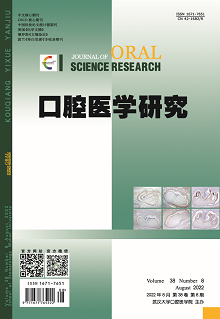|
|
Anatomical Presentation of Maxillary First Molar Site in Cone-beam CT
WANG Xiaodong, MENG Lingjiao, ZHAO Bing, CHEN Zhifang
2022, 38(8):
784-788.
DOI: 10.13701/j.cnki.kqyxyj.2022.08.017
Objective: To analyze the bone anatomy of maxillary first molar (M1) by CBCT. Methods: The current retrospective study included 548 maxillary sinus CBCT images. Parameters such as maxillary sinus lateral wall thickness (LWT) and maxillary sinus width (SW) at 5 mm (LWT-5, SW-5) and 10 mm (LWT-10, SW-10) height levels from the sinus floor, angle A, palatal–nasal recess angle (PNR), and distance from the palatal-nasal recess to the alveolar crest (DPA) were subjected to statistical analysis. Results: Mean LWT-5 and LWT-10 were (1.99±1.07) mm and (2.32±1.60) mm. Mean SW-5 and SW-10 were (14.56±2.83) mm and (19.81±3.91) mm. In angle A, the group of less than 30° was 0.18%, 30°-60° was 13.14%, and greater than 60° was 86.68%. In PNR, the group of less than 90° was 9.85%, and greater than or equal to 90° was 90.15%. At M1 sites, 5.66% of the recesses were less than 90° and within 15 mm from the alveolar crest. The LWT-5, SW-5, and SW-10 in the male group were significantly greater than those in the female group (P<0.05). There was statistically significant difference on the LWT-5, SW-5, and DPA with respect to presence or absence of tooth (P<0.05). There was a significant association between SW-5 and age (P<0.05). There was statistically significant difference on the LWT-5, LWT-10, and SW-10 with respect to presence or absence of the alveolar antral artery canal (P<0.001). Conclusion: The LWT, SW, angle A, PNR, and DPA might present a challenge for performing sinus augmentation. These anatomic structures should be carefully evaluated.
References |
Related Articles |
Metrics
|

